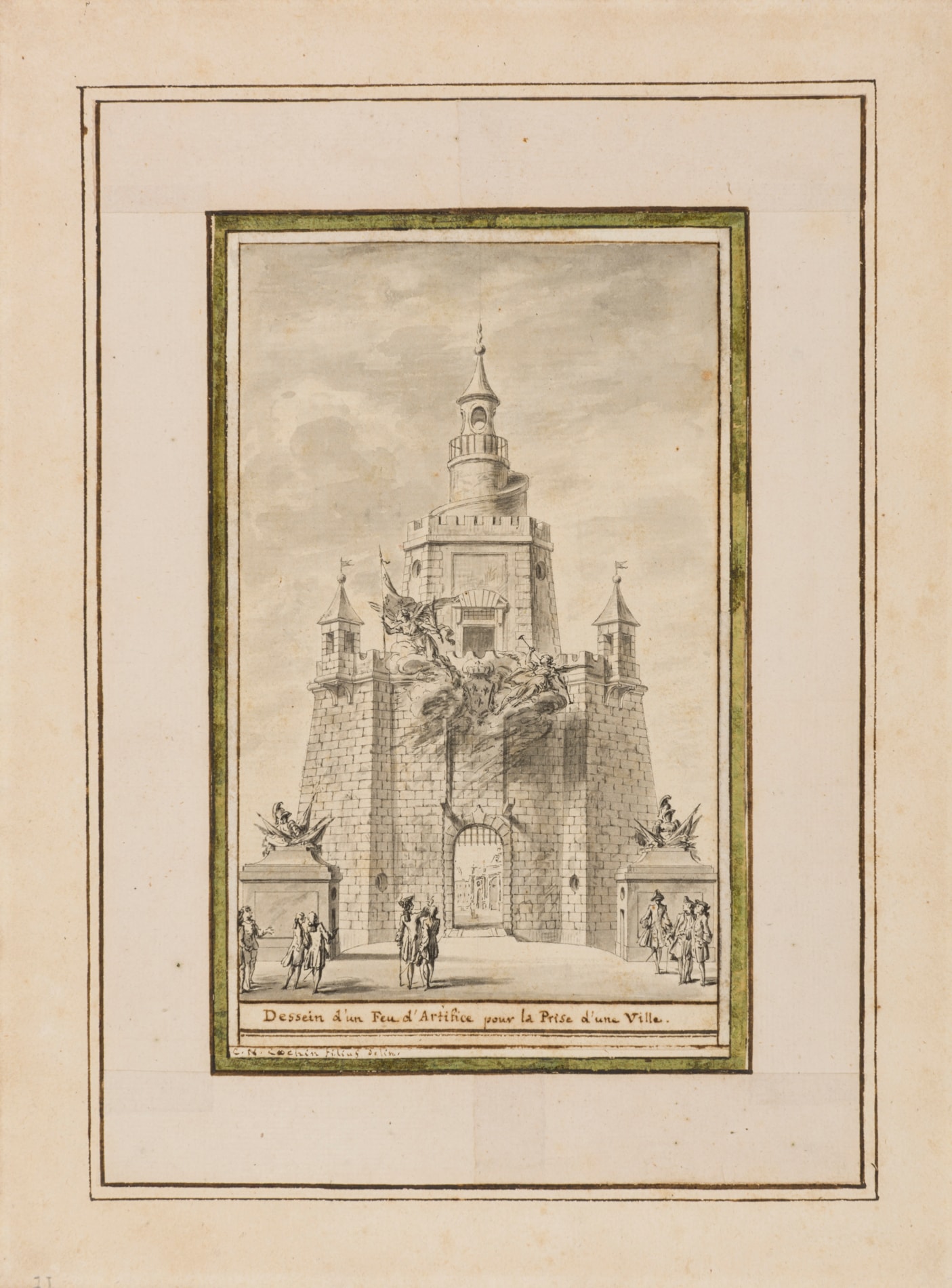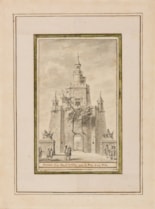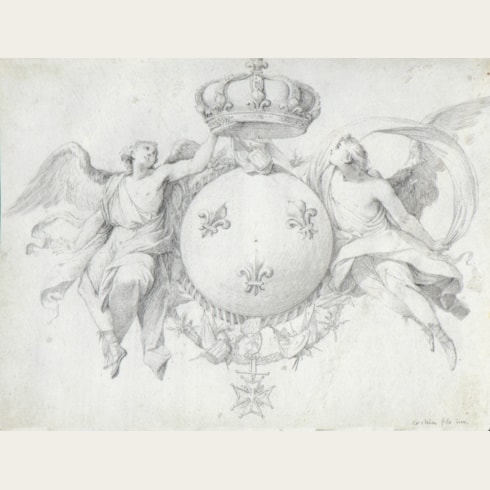Charles-Nicolas COCHIN
(Paris 1715 - Paris 1790)
Design for a Fireworks Display
Sold
Pen and black ink and grey wash, with framing lines in brown ink, laid down on an 18th or 19th century mount.
Signed C. N. Cochin filius delin. in the lower left margin.
Titled Dessein d’un Feu d’Artifice pour la Prise d’une Ville. in the bottom margin.
171 x 107 mm. (6 3/4 x 4 1/4 in.)
ACQUIRED BY THE PRINCETON UNIVERSITY ART MUSEUM, PRINCETON, NJ.
Signed C. N. Cochin filius delin. in the lower left margin.
Titled Dessein d’un Feu d’Artifice pour la Prise d’une Ville. in the bottom margin.
171 x 107 mm. (6 3/4 x 4 1/4 in.)
ACQUIRED BY THE PRINCETON UNIVERSITY ART MUSEUM, PRINCETON, NJ.
This is a preparatory study by Cochin for an engraved illustration, in reverse, that appeared in a new and revised edition of the French military engineer and explorer Amedée François Frézier’s book 'Traité des feux d’artifice pour le spectacle', published by Jombert in 1747. First published in 1707, Frézier’s book was a comprehensive treatise on fireworks, rockets and pyrotechnics for ceremonial, recreational and military use, and also described the science, background and manufacture of decorative fireworks.
The printed caption of Cochin’s illustration in Frézier’s book provides a description of the structure here depicted: ‘The Theatre of Fireworks (Théatre d’Artifice) illustrated on this plate relates to some military expedition, such as a successful battle, the capture of a city, etc. The body of the edifice is a fortress, whose main entrance is announced by two entry boxes on both sides of the door, to house sentries, and at the same time to serve as a base for the military trophies placed above. On the top of the walls one can see on one side the figure of Victory, who plants the flag of the victor, and on the other side, the figure of Fame sets forth to announce the news to the whole world. This structure is completed by a keep or a very tall belfry, the top of which is reached by a spiral ramp that runs along the outside of this keep. This decoration is in the style of the Théatre d’Artifice that was erected in Paris in front of the Hôtel de Ville in celebration of the taking of the city of Ypres by His Majesty on 27 June 1744.’
This drawing may have once belonged to Cochin’s friend, patron and publisher Charles-Antoine Jombert (1712-1784), who commissioned his first book illustrations from Cochin in 1737 and continued his close professional relationship with the artist until his death. In all, Jombert owned 284 of Cochin’s drawings, almost all of which were studies for book illustrations, and these were dispersed at auction in Paris in 1776.
The printed caption of Cochin’s illustration in Frézier’s book provides a description of the structure here depicted: ‘The Theatre of Fireworks (Théatre d’Artifice) illustrated on this plate relates to some military expedition, such as a successful battle, the capture of a city, etc. The body of the edifice is a fortress, whose main entrance is announced by two entry boxes on both sides of the door, to house sentries, and at the same time to serve as a base for the military trophies placed above. On the top of the walls one can see on one side the figure of Victory, who plants the flag of the victor, and on the other side, the figure of Fame sets forth to announce the news to the whole world. This structure is completed by a keep or a very tall belfry, the top of which is reached by a spiral ramp that runs along the outside of this keep. This decoration is in the style of the Théatre d’Artifice that was erected in Paris in front of the Hôtel de Ville in celebration of the taking of the city of Ypres by His Majesty on 27 June 1744.’
This drawing may have once belonged to Cochin’s friend, patron and publisher Charles-Antoine Jombert (1712-1784), who commissioned his first book illustrations from Cochin in 1737 and continued his close professional relationship with the artist until his death. In all, Jombert owned 284 of Cochin’s drawings, almost all of which were studies for book illustrations, and these were dispersed at auction in Paris in 1776.
The son of an engraver of the same name, Charles-Nicolas Cochin fils followed in his father’s footsteps as a printmaker. From 1735 onwards he was employed at the Menus-Plaisirs du Roi, producing drawings and engravings of all the major events, festivals and ceremonies of the Royal court. He is best known today, however, for his portrait drawings of some of the leading men and women of 18th century France, and for his parallel career as a book illustrator. Indeed, by the end of his life Cochin had contributed illustrations and vignettes to more than two hundred books, many of these commissions achieved through the intervention of the bookseller and publisher Charles-Antoine Jombert. His illustrations were, as one modern scholar has noted, ‘marked not only by the mastery of outline and firmness of composition which never deserted him, but also by acute observation and unpretentious humor. They remain fresh and attractive today.’2 Cochin’s position as the leading engraver in France for much of the 18th century was further strengthened by the lifelong friendship and protection of the Marquis de Marigny, Directeur des Bâtiments du Roi from 1751 onwards. With the support of Marigny, Cochin rose to a position of considerable power and influence at the Bâtiments du Roi, of which he was given charge of the administration. He also published a number of theoretical writings on art, notably the Lettres à un jeune artiste peintre, which appeared in c.1774.
Provenance
Probably Charles-Antoine Jombert, Paris
Probably the vente Jombert, Paris, 15 April 1776
Galerie Cailleux, Paris
Rosenberg & Stiebel, New York
Private collection.
Probably the vente Jombert, Paris, 15 April 1776
Galerie Cailleux, Paris
Rosenberg & Stiebel, New York
Private collection.
Literature
Stanford University, Cantor Center for Visual Arts, Classic Taste: Drawings and Decorative Arts from the Collection of Horace Brock, March-May, 2000.





